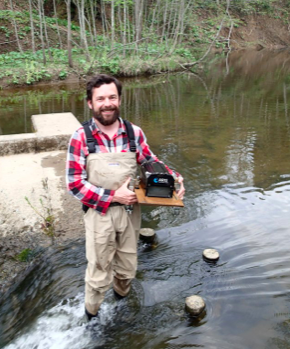 Click here to view article as a PDF.
Click here to view article as a PDF.
What exotic creature grows up to 2 meters (about 6 feet) long and over 50 kilograms (100 lbs.) in mass, is nicknamed the “river wolf”, and lives in the icy waters of Northern Japan and Eastern Russia? Known as Sakhalin Taimen, or locally as Hucho Perryi, this ancient and little-known species is the largest salmonid in the world, and occupies a unique ecological niche.
Due to overfishing and land use development of its native habitat, the species has been declared critically endangered by the International Union for Conservation of Nature (IUCN). The Taimen’s long and complex life cycle as well as its small population size has made previous study of the species difficult, leaving major gaps in our understanding of the Taimen and how to ensure their survival.
That is why Dr. Peter Rand, Senior Conservation Biologist at the Wild Salmon Center for the conservation of salmon ecosystems, and his colleague, Dr. Michio Fukushima at the National Institute for Environmental Studies, Japan, have been conducting studies of the Taimen species up close in Japan’s Sarufutsu River during the spring of both 2013 and 2014.
Located on the Northern tip of Japan, the Sarufutsu is one of the few last untampered Taimen habitats in the world, where the Wild Salmon Center currently works together with several local partners with the twofold goal to research and also increase awareness for the endangered species. This past spring, Dr. Rand conducted a 3-month study using Sound Metric’s ARIS Explorer 3000 to establish a new monitoring system in order to count sea-run Taimen and estimate the current size of the river’s Taimen population.
Dr. Rand, an aquatic ecologist with 20 years of experience in teaching and conservation efforts, described how a transition was made from more rudimentary equipment to Sound Metrics’ multibeam acoustic sonars for more accurate study of Taimen in the Sarufutsu. A committed group of volunteers originally used to walk up and down the river counting salmon and their nests by sight. However, volunteer estimates were necessarily rough, as it takes a trained eye to spot Taimen nests, and it is nearly impossible to keep an accurate salmon count during stormy weather or at night.
With the use of Sound Metrics’ sonar technology, all of these problems could be solved while saving additional volunteers time and effort. Dr. Rand first employed a DIDSON multi-beam imaging sonar last spring of 2013 for his Sarufutsu studies, and was immediately impressed with the quality results and intuitive nature of DIDSON. He had worked with more simple single and split-beam systems in the past, but DIDSON technology allowed him for the first time to take video images of the Taimen while collecting detailed data analytics on the images as well.
This year, Dr. Rand reached out to Jeanne Dorsey, Sales Representative for Sound Metrics from Ocean Marine Industries, to inquire about using a sonar for a second time. We were happy to assist in his conservation efforts, and Ocean Marine Industries provided Dr. Rand with Sound Metrics’ latest sonar model, ARIS Explorer 3000, at a substantially reduced rental rate for the duration of his project.
Dr. Rand found his preferred tool for the job with the ARIS 3000, saying that he noticed a marked improvement the ARIS makes in image resolution over DIDSON, “I collected much better, higher quality data using the ARIS, as well as more accurate length estimates of the salmon.” He also spoke highly of the ARIS software, saying “I was very impressed with the interface and analysis, it did a great job overall.” Dr. Rand now feels very confident in identifying the Taimen from other salmon species in the river, distinguishing between male and female Taimen, and in the final salmon count reached at the end of the study.
The final number of Taimen counted came in at a very promising 425 salmon, which was much higher than what Dr. Rand and his colleagues anticipated, and up from last spring’s count of 335 salmon. Though these numbers bode well for the health of the Taimen population in the Sarafutsu, Dr. Rand and his team know that their job to raise awareness for this large and ancient species has only just begun.
The next steps are to work with the local conservationist group to educate anglers and the local community about the Taimen. Anglers represent an important audience to reach due to recreational fishing pressure on the endangered salmon, especially in Japan where there are no fishing licenses required and no official fishing regulation. Based on their research, Dr. Rand estimates that this spring’s study sampled about a third of the Taimen population in the Sarufutsu. “So multiply our final count of 425 fish by 3 and you get roughly 1,000, which is exactly how many Taimen a recent survey revealed are caught and released in a year for recreational purposes.”
According to Dr. Rand’s study, the Taimen population in the Sarufutsu is large and healthy, but also at risk from recreational fishing pressures. The Wild Salmon Center will continue to work with their partners in Japan to communicate the status of the species to local communities, as well as educate anglers on the best practices to use when fishing for Taimen, such as using fish hooks without barbs and keeping the fish in the water when they have been landed.
Dr. Rand sees this spring’s study as a success enabled by ARIS, Sound Metrics’ latest up-close acoustic sonar for underwater imaging. He and his colleagues in Japan and at the Wild Salmon Center look forward to continuing to build strong programs protecting the health of the world’s largest salmon not only in the Sarufutsu but in Taimen habitats everywhere. We look forward to seeing all that they and ARIS can accomplish together!